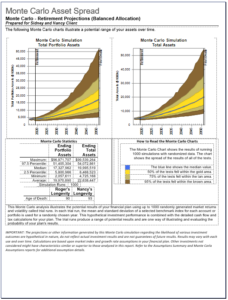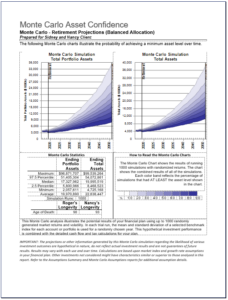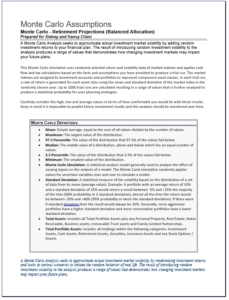Published on: 07/12/2016 • 10 min read
The Value of Monte Carlo Simulations in Financial Planning

As part of our financial planning process, when clients have to make important decisions, we like to “stress test” their plan. One of the tools that we may use is a Monte Carlo simulation. When used in coordination with our traditional straight-line financial planning projections and our “Hurdle Rate” calculations, Monte Carlo helps us compare different retirement planning options or scenarios to help project and illustrate which alternatives will have the highest probability of success (success is defined as our client’s reaching financial goals). Bottom line Monte Carlo is a tool that can help us help our clients make better and more informed retirement and investment planning decisions.
Estimating Investment Returns
All financial forecasts must account for variables like inflation rates, market volatility and investment returns. The catch is that these variables have to be estimated, and the estimate used is key to a forecast’s results. For example, a forecast that assumes stocks will earn an average of 4% each year for the next 20 years will differ significantly from a forecast that assumes an average annual return of 8% over the same period.
Estimating investment returns is particularly difficult. For example, the volatility of stock returns can make short-term projections almost meaningless. Multiple factors influence investment returns, including events such as natural disasters and terrorist attacks, which are unpredictable. So, it’s important to understand how different forecasting methods handle uncertainty.
Basic forecasting methods
Straight-line forecasting methods assume a constant value for the projection period. For example, a straight-line forecast might show that a portfolio worth $116,000 today would have a future value of approximately $250,000 if the portfolio grows by an annual compounded return of 8% for the next 10 years. This projection is helpful, but it has a flaw: In the real world, returns aren’t typically that consistent from year to year. One example of this is that your retirement results may turn out very different if your retirement starts out in a bear market (like in 2000 or 2008). I discussed this in an article that appeared in CNBC.com called “Afraid of Retiring into a bear market? Tips to hedge bets”
Forecasting methods that utilize “scenarios” provide a range of possible outcomes. Continuing with the 10-year example above, a “best-case scenario” might assume that your portfolio will grow by an average 10% annual return and reach $300,000. The “most-likely scenario” might assume an 8% return (for a $250,000 value), and the “worst-case scenario” might use 4%, resulting in roughly $171,000. Scenarios give you a better idea of the range of possible outcomes. However, they aren’t precise in estimating the likelihood of any specific result.
Forecasts that use Monte Carlo analysis are based on computer-generated simulations. You may be familiar with simulations in other areas; for example, local weather forecasts are typically based on a computer analysis of national and regional weather data. Similarly, Monte Carlo financial simulations rely on computer models to replicate the behavior of economic variables, financial markets, and different investment asset classes.
Why is a Monte Carlo simulation useful?
In contrast to more basic forecasting methods, a Monte Carlo simulation is designed to account for volatility, especially the volatility of investment returns. It enables you to see a spectrum of thousands of possible outcomes, taking into account not only the many variables involved, but also the range of potential values for each of those variables.
By attempting to replicate the uncertainty of the real world, a Monte Carlo simulation can provide a detailed illustration of how likely it is that a given investment strategy might meet your needs. For example, when it comes to retirement planning, a Monte Carlo simulation can help you answer specific questions, such as:
- Given a certain set of assumptions, what is the probability that you will run out of funds before age 90?
- If that probability is unacceptably high, how much additional money would you need to invest each year to decrease the probability to 10%?
- Will I be better off if I have a more aggressive portfolio allocation vs. a more conservative portfolio allocation?
The mechanics of a Monte Carlo simulation
A Monte Carlo simulation typically involves hundreds or thousands of individual forecasts or “iterations,” based on data that you provide (e.g., your portfolio, time frames, and financial goals). Each iteration draws a result based on the historical performance of each investment class included in the simulation.
Each asset class – Large-cap stocks, corporate bonds, etc. – has an average (or mean) return for a given period. Standard deviation measures the statistical variation of the returns of that asset class around its average for that period. A higher standard deviation implies greater volatility. The returns for stocks have a higher standard deviation than the returns for U.S. Treasury bonds, for instance.
There are various types of Monte Carlo methods, but each generates a forecast that reflects varying patterns of returns. Software modeling stock returns, for example, might produce a series of annual returns such as the following: Year 1: -7%; Year 2: -9%; Year 3: +16%, and so on. For a 10-year projection, a Monte Carlo simulation will produce a series of 10 randomly generated returns–one for each year in the forecast. A separate series of random returns is generated for each iteration in the simulation and multiple combined iterations are considered a simulation. A graph of a Monte Carlo simulation might appear as a series of statistical “bands” around a calculated average.
Example: Let’s say a Monte Carlo simulation performs 1,000 iterations using your current retirement assumptions and investment strategy. Of those 1,000 iterations, 600 indicate that your assumptions will result in a successful outcome; 400 iterations indicate you will fall short of your goal. The simulation suggests you would have a 60% chance of meeting your goal.
Pros and cons of Monte Carlo
A Monte Carlo simulation illustrates how your future finances might look based on the assumptions you provide. Though a projection might show a very high probability that you may reach your financial goals, it can’t guarantee that outcome. However, a Monte Carlo simulation can illustrate how changes to your plan could affect your odds of achieving your goals. In my opinion, the probability of success in an individual outcome is not what is overly important, but rather it is whether one scenario has a HIGHER probability of success versus another alternative that is the trust value of a Monte Carlo analysis. When combined with periodic progress reviews and plan updates, Monte Carlo forecasts help us to guide our clients into making better and more informed financial planning decisions.
Important Note on Monte Carlo: The projections or other information generated by Monte Carlo analysis tools regarding the likelihood of various investment outcomes are hypothetical in nature, do not reflect actual investment results, and are not guarantees of future results. Results may vary with each use and over time. Because of the many variables involved, an investor should not rely on forecasts without realizing their limitations.
(Sample Monte Carlo Projection from eMoney Advisor)




A Monte Carlo Analysis seeks to approximate actual investment market volatility by randomizing investment returns and looks at various scenarios to imitate the random behavior of real life. The result of introducing random investment volatility to the analysis produces a range of values that demonstrates how changing investment markets may impact your future plans.
This Monte Carlo simulation uses randomly selected return and volatility data of benchmark indices. The benchmark index data includes gross monthly returns collected over a span of years of changing market conditions. These benchmark indices are tied to asset classes which are associated to the securities in each investment account or model portfolio in your financial plan. Monte Carlo uses your existing holdings in your financial plan for its trial runs. A blended rate of return for each investment account is calculated based on the underlying benchmark indices that are associated to the asset classes within the account or assigned model portfolio by multiplying the index rate by the percentage allocation for each asset class.
Note that certain of your investments may have fixed growth rates assigned, in which case the fixed rate is used in each trial run. Please refer to the Monte Carlo Assumptions report for a listing of your investments to which fixed growth rates have been assigned. The Monte Carlo Assumptions report also provides definitions for terms associated with Monte Carlo simulation.
Up to 1000 trial runs are calculated, resulting in a range of values that is further analyzed to produce a statistical probability for your planning strategies. In each trial run, a rate of return is generated using the mean and standard deviation of the benchmark index in the randomly chosen year, and your cash flow is evaluated using the tax assumptions based on the facts and assumptions you have provided. Please refer to the Assumptions Summary report for your tax rate assumptions. Each run randomly chooses a year from the range of historical data available for each benchmark index that underlies each asset class. Next, a rate of return is generated for each asset class using the historical mean and standard deviation of the benchmark index in that chosen year. The results of each run are then plotted on a graph to show the range of potential outcomes. The calculations plotted on the Monte Carlo graphs illustrate the range of potential results: the best case scenario, the worst case scenario, and hundreds of scenarios in between.
While the simulation does not predict what the market will do, 1000 trial runs provide the range of possible returns for your financial plan with greater confidence. Carefully consider the high, low and average values in terms of how comfortable you would be with those results. Keep in mind it is impossible to predict future investment results, and this analysis should be monitored over time.
Please note that other investments not considered might have characteristics similar or superior to those analyzed in this report.
Please refer to the Growth Rates Summary report for a detailed listing of the historical benchmark indices, model portfolios, and for a listing of your investments with their assigned growth rates.
IMPORTANT: The projections or other information generated by this Monte Carlo simulation regarding the likelihood of various investment outcomes are hypothetical in nature, do not reflect actual investment results and are not guarantees of future results. There is no guarantee that the results generated by this simulation will be achieved or sustained, and results may vary with each use and over time. Actual results may be better or worse than those generated in this simulation.
Limitations of this Monte Carlo simulation include:
• Investments assigned fixed rates of return reflect a constant growth rate, which is compounded on an annual basis with no variation and have no underlying correlation data. The growth on investments is the flat rate throughout the Monte Carlo simulation.
• Market volatility may be more extreme than what is represented by the simulation
• The accuracy of the simulation is reduced in periods of market crisis.
• The simulation does not consider all investments, and those not considered might have characteristics similar or superior to those analyzed in this report.
IMPORTANT DISCLOSURE:
Financial Planning and Investment Advice offered through Avidian Wealth Management, a registered investment advisor. Avidian does not provide tax or legal advice and the information presented here is not specific to any individual’s personal circumstances. To the extent that this material concerns tax matters or legal issues, it is not intended or written to be used, and cannot be used, by a taxpayer for the purpose of avoiding penalties that may be imposed by law. Each taxpayer should seek independent advice from a tax professional based on his or her individual circumstances. These materials are provided for general information and educational purposes based upon publicly available information from sources believed to be reliable—we cannot assure the accuracy or completeness of these materials. The information in these materials may change at any time and without notice.
IRS CIRCULAR 230 NOTICE: To the extent that this message or any attachment concerns tax matters, it is not intended to be used and cannot be used by a taxpayer for the purpose of avoiding penalties that may be imposed by law.
Please read important disclosures here
Get Avidian's free market report in your inbox

Schedule a conversation
Curious about where you stand today? Schedule a meeting with our team and put your portfolio to the test.*